Eutech Instruments pH 300, pH310 User Manual
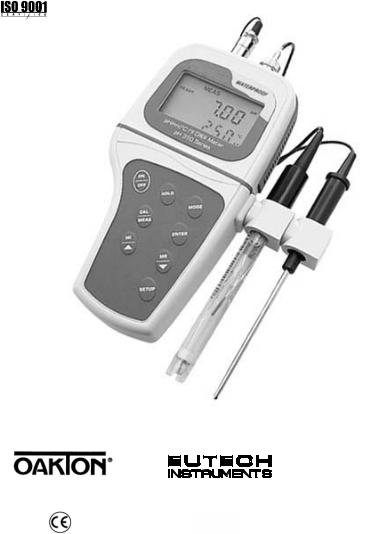
Instruction Manual
pH 300/310
Waterproof Hand-held pH / mV / Temperature Meter
Technology Made Easy ...
68X248901
rev 6 08/04
Preface
This manual serves to explain the use of the waterproof pH 300/310 hand-held meter. It functions in two ways, firstly as a step by step guide to help you to operate the meter. Secondly, it serves as a handy reference guide. It is written to cover as many anticipated applications of the waterproof pH 300/310 meter as possible. If there are doubts in the use of the meter, please do not hesitate to contact the nearest Authorized Distributor.
Eutech Instruments/ Oakton Instruments cannot accept any responsibility for damage or malfunction to the meter caused by improper use of the instrument.
The information presented in this manual is subject to change without notice as improvements are made, and does not represent a commitment on the part of Eutech Instruments Pte Ltd/ Oakton Instruments.
Copyright © 1999
Eutech Instruments Pte Ltd/ Oakton Instruments
All rights reserved.
Rev 6, 08/04.
TABLE OF CONTENTS
1 |
INTRODUCTION |
1 |
|
2 |
DISPLAY AND KEYPAD FUNCTIONS |
2 |
|
2.1 |
Display |
2 |
|
2.2 |
Keypad |
3 |
|
2.3 |
Inserting the Batteries |
4 |
|
2.4 |
Connecting the Electrode and Temperature Probe |
5 |
|
2.5 |
Attaching the Electrode Holder to the Meter |
7 |
|
2.6 |
Inserting the Electrode into the Electrode Holder |
7 |
|
3 |
CALIBRATION |
8 |
|
3.1 |
Important Information on Meter Calibration |
8 |
|
3.2 |
Preparing the Meter for Calibration |
8 |
|
3.3 |
pH Calibration |
10 |
|
3.4 |
Relative mV Calibration |
12 |
|
3.5 |
Temperature Calibration |
13 |
|
4 |
MEASUREMENT |
14 |
|
4.1 |
Automatic Temperature Compensation |
14 |
|
4.2 |
Manual Temperature Compensation |
15 |
|
4.3 |
Taking Measurements |
16 |
|
5 |
HOLD FUNCTION |
17 |
|
6 |
MEMORY FUNCTION |
18 |
|
6.1 |
Memory Input |
18 |
|
6.2 |
Memory Recall |
19 |
|
7 |
ADVANCED SETUP FUNCTIONS |
21 |
|
7.1 |
Advanced SET-UP Mode Overview |
23 |
|
7.2 |
P 1.0: Memory Clear (CLr) |
25 |
|
7.3 |
P2.0: Viewing previous calibration data |
26 |
|
7.4 |
P3.0: Viewing electrode data |
27 |
|
7.5 |
P4.0: Unit configuration |
29 |
|
7.6 |
P5.0: Resetting to factory default settings |
34 |
|
7.7 |
P5.0: Setting the real-time clock |
35 |
|
7.8 |
P6.0: Resetting to factory default settings |
37 |
|
8 |
PROBE CARE AND MAINTENANCE |
38 |
|
9 |
TROUBLE SHOOTING GUIDE |
40 |
|
10 |
ERROR MESSAGES |
41 |
|
11 |
SPECIFICATIONS |
42 |
|
12 |
ACCESSORIES |
43 |
|
13 |
ADDENDUM 1: METER FACTORY DEFAULT SETTINGS |
46 |
|
14 |
WARRANTY |
47 |
|
15 |
RETURN OF ITEMS |
48 |
|

1 INTRODUCTION
Thank you for selecting this meter. The waterproof pH 300/310 Hand-held meter is a microprocessor-based instrument that is designed to be handy and user-friendly. It is capable of measuring pH, mV and temperature. It is designed to be handy and capable of allowing one-hand operation. It is completely WATERPROOF --- and it FLOATS!
This meter has many user-friendly features – all of which are completely accessible through the water-resistant membrane keypad. Your meter includes a temperature probe, two electrode holders, batteries, instruction manual and a warranty card. Complete portable testing versions, including a rugged carrying case and calibration solutions, are also available. Refer to the Accessories section for more information.
Please read this manual thoroughly before operating your meter.
1
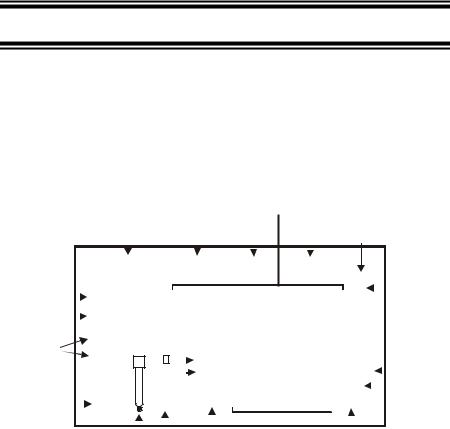
2 DISPLAY AND KEYPAD FUNCTIONS
2.1Display
The LCD has a primary and secondary display.
•The primary display shows the measured pH, mV or Relative mV value.
•The secondary display shows the measured temperature.
The display also shows error |
messages, |
keypad |
functions and program functions. |
|||||
See Figure 1. |
|
|
|
|
|
|
|
|
|
|
|
|
Primary Display |
|
|||
1 |
2 |
3 |
4 |
5 |
||||
|
|
|
|
|
|
|
|
|
|
|
|
|
|
|
|
|
|
|
|
|
|
|
|
|
|
|
|
|
|
|
SETUP |
|
|
MEAS CAL MEM |
|
R.mV |
|
|
|||||||||||||||||||||||
18 |
|
|
|
READY |
-8.8.8.8 |
pH |
|
|
6 |
|||||||||||||||||||||||||
|
|
|
|
|
||||||||||||||||||||||||||||||
|
|
|
|
|
|
|
|
|
|
|||||||||||||||||||||||||
16 |
|
|
|
ON |
|
|
|
|
|
|
|
|||||||||||||||||||||||
17 |
|
|
|
HOLD |
|
|
|
|
|
|
|
|
|
|
|
|
|
|
|
|
|
|
|
|
|
|
|
|
|
|||||
|
|
|
|
OFF |
|
|
|
|
|
|
|
|
|
|
MEM |
|
|
|
|
|
|
°C °F |
|
|
7 |
|||||||||
15 |
|
|
|
|
|
|
|
|
|
|
|
|
|
|
|
|
|
ERR |
|
|
|
|
|
|
|
|
||||||||
|
|
|
|
|
|
|
|
|
|
|
|
|
|
|
|
|
AM-1.8.8.8 ATC |
|
|
|||||||||||||||
|
|
|
|
|
|
|
|
|
|
|
|
|
|
|
|
|
|
|
PM |
|
|
|
|
|
|
pH |
|
8 |
||||||
|
|
|
|
|
|
|
|
|
|
|
|
|
|
|
|
|
|
|
|
|
|
|
|
|
|
|
|
|
|
|
|
|
||
|
|
|
|
|
|
|
|
|
|
|
|
|
|
|
|
|
11 |
|
|
|
|
|
|
|
|
|
|
|
|
|
|
|
|
|
|
|
|
|
|
|
|
|
|
|
|
|
|
|
|
|
|
|
|
|
|
Secondary |
|
Display |
|
9 |
|
|
|
|
|
||||
|
|
|
|
14 |
13 |
|
|
|
10 |
|
|
|
|
|
|
|
||||||||||||||||||
|
|
|
|
12 |
|
|
|
|
|
|
|
|||||||||||||||||||||||
|
|
|
|
|
|
|
|
|
|
|
|
|
|
|
|
|
|
|
||||||||||||||||
|
|
|
|
|
|
|
|
|
|
|
|
|
|
|
|
Figure 1: Full LCD Screen |
|
|
|
|
|
|
|
|
|
|
|
|||||||
1. SETup mode indicator |
|
|
7. Temperature indicator (°F |
13. Low battery indicator |
||||||||||||||||||||||||||||||
|
|
|
|
|
|
|
|
|
|
|
|
|
|
|
|
available on pH 310 meter |
|
|
|
|
|
|
|
|
|
|
|
|||||||
|
|
|
|
|
|
|
|
|
|
|
|
|
|
|
|
only) |
|
|
|
|
|
|
|
|
|
|
|
|
|
|
||||
2. MEASurement mode |
|
|
8. pH buffer selection indicator |
14. Probe indicator |
||||||||||||||||||||||||||||||
indicator |
|
|
|
|
|
|
|
|
|
|
|
|
|
|
|
|
|
|
|
|
|
|
|
|
|
|
|
|
|
|
|
|||
3. CALibration indicator |
|
|
9. Automatic Temperature |
15. Buffer indicator |
||||||||||||||||||||||||||||||
|
|
|
|
|
|
|
|
|
|
|
|
|
|
|
|
Compensation indicator |
|
|
|
|
|
|
|
|
|
|
|
|||||||
4. MEMory recall mode |
|
|
10. Clock indicator (pH 310 |
16. Function ON/OFF indicator |
||||||||||||||||||||||||||||||
indicator |
|
|
|
|
|
|
|
|
|
|
|
|
meter only) |
|
|
|
|
|
|
|
|
|
|
|
|
|
|
|||||||
5. mV or Relative mV indicator |
|
|
11. ERRor indicator |
17. HOLD indicator |
||||||||||||||||||||||||||||||
6. pH indicator |
|
|
|
|
|
|
|
|
12. MEMory location indicator |
18. READY indicator |
||||||||||||||||||||||||
2
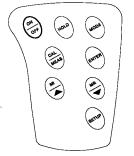
2.2Keypad
The large membrane keypad makes the instrument easy to use. Each button, when pressed, has a corresponding graphic indicator on the LCD. See Figure 2. Some buttons have several functions depending on its mode of operation.
Key |
|
|
Function |
|
ON/OFF |
Powers on and shuts off the meter. When you switch on the meter, the meter starts up in the |
|||
|
mode that you last switched off from. For example, if you shut the meter off in mV |
|||
|
measurement mode, the meter will be in mV measurement mode when you switch the meter |
|||
|
on. |
|
|
|
HOLD |
Freezes the measured reading. To activate, press HOLD while in measurement mode. To |
|||
|
release, press HOLD again. |
|||
|
pH 310 model only: When auto endpoint feature is switched on, it automatically holds reading |
|||
|
|
after 5 seconds of stability. The HOLD indicator appears on the display. |
||
|
|
Press HOLD to release auto endpoint feature. |
||
MODE |
Selects the measurement parameter. Press MODE to toggle between pH, mV (or relative mV) |
|||
|
and date/time [date/time feature available on pH 310 model only]. |
|||
CAL/MEAS |
Toggles between Calibration and Measurement mode. |
|||
|
1. |
If you were in pH Measurement mode, press CAL/MEAS to enter pH Calibration mode. |
||
|
|
NOTE: Temperature calibration is available from pH Calibration mode. See page 13 for |
||
|
|
directions. |
||
|
2. |
If you were in mV Measurement mode, press CAL/MEAS to enter mV Calibration mode. |
||
|
While in SETUP main menu, pressing CAL/MEAS takes you out directly into the measurement |
|||
|
mode. |
|
|
|
ENTER |
1. |
To confirm your calibration values in Calibration mode. |
||
|
2. |
To confirm selections in SETUP mode. |
||
|
In Measurement mode: |
|||
MI/▲ & |
Press MI/▲ (memory input) to store values with its corresponding temperature values in the |
|||
MR/▼ |
memory. Press MR/▼ (memory recall) to retrieve data from memory. |
|||
|
In SETUP mode: |
|||
|
Press to scroll through the setup subgroup programs. |
|||
|
In mV calibration mode: |
|||
|
Press to adjust the calibration value. |
|||
SETUP |
Takes you into the SETUP mode. This mode lets you customize meter preference and |
|||
|
defaults, and view calibration and electrode offset data. |
|||
|
|
|
|
|
|
|
|
|
|
Figure 2 - Keypad
3
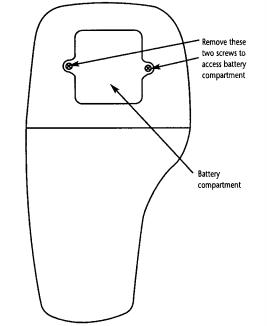
2.3Inserting the Batteries
Four AAA batteries are included with your meter.
1.Use a Philips screwdriver to remove the two screws holding the battery cover. See Figure 3 below.
2.Remove battery cover to expose batteries.
3.Insert batteries. Follow the diagram inside the cover for correct polarity.
4.Replace the battery cover into its original position using the two screws removed earlier.
Figure 3 - Back panel of meter showing battery compartment
4
2.4Connecting the Electrode and Temperature Probe
The waterproof pH 300/310 handheld pH meter uses any standard pH, ORP, or ISE electrode with a BNC connector. For Automatic Temperature Compensation (ATC), this meter requires a temperature probe with a special 6-pin connector.
Use either:
•All electrode with a BNC connector and a separate temperature probe with 6-pin connector (EC-PHWPTEM-01W/ 35618-05).
•A “3-in-1” combination pH electrode with temperature probe designed specifically for pH 300 and pH 310 waterproof meters.
Refer to “Accessories” section on page 43 for more information on temperature probe and other electrodes.
NOTE: Keep connectors dry and clean. Do not touch connector with soiled hands.
To connect the pH, ORP or ISE electrode:
1.Slide the BNC connector of the probe over the BNC connector socket on the meter. Make sure the slots of the connector are in line with the posts of the socket. Rotate and push the connector clockwise until it locks.
5.To remove electrode, push and rotate the connector counterclockwise. While holding onto the metal part of the connector, pull it away from the meter.
CAUTION: Do not pull on the probe cord or the probe wires might disconnect.
To connect the temperature probe:
1.Line up the notch and 6 pins on the probe connector with the holes in the connector located on the top of the meter. Push down and screw the metal sleeve to lock the probe connector into place. See Figure 4.
6.To remove probe, unscrew the metal sleeve and slide up the probe connector. While holding onto metal sleeve, pull probe away from the meter.
CAUTION: Do not pull on the probe cord or the probe wires might disconnect.
5
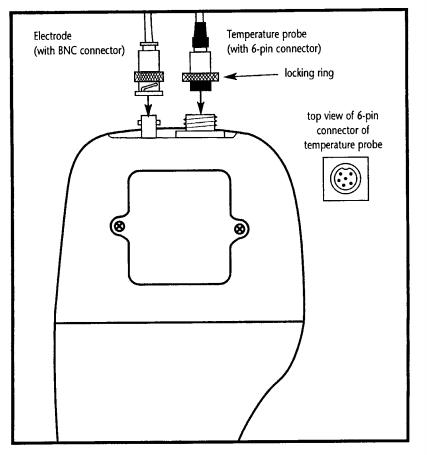
Figure 4 - Connection for pH Electrode (BNC) and Temperature probe (6-pin connector)
6
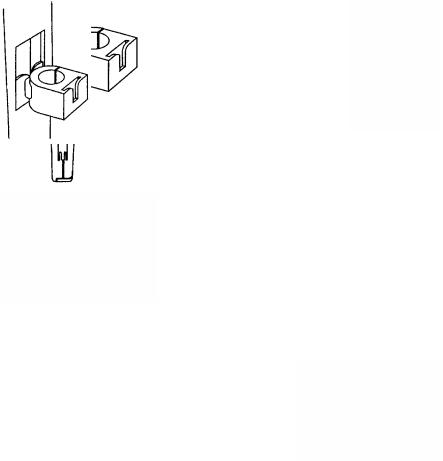
2.5Attaching the Electrode Holder to the Meter
The waterproof pH 300/310 handheld meter comes complete with two electrode holders. They are designed to facilitate one-hand operation. Attach two electrode holders if you have a separate electrode and temperature probe. Care must always be taken to avoid use of excessive force in the process of attaching these components.
1.Locate the slot on the right-hand side of the meter.
2.Gently slide the flange of the holder into the slot on the
meter. Make sure the holder is secured properly into the slot. See figure 5.
Figure 5 - Holder slot into right-hand side of meter
Figure 6 - Electrode can be placed in different positions with holder
3.You can attach the electrode holder in different positions. See figure 6.
To attach a second electrode holder:
4.Align the flange of the second electrode holder with the slot of the first holder.
5.Slide the flange of the second holder into the slot of the first holder until the tops of the holders are aligned and secure. See figure 7.
2.6 Inserting the Electrode into the Electrode Holder
Do not use excessive force when inserting electrodes into the |
|
|
holders. |
|
|
Insert the pH electrode into the opening of the first holder until |
Figure 7 - Two holders |
|
the top housing of the electrode touches the top of the holder. |
||
|
If you are using a separate temperature probe, insert the probe into the opening of the second holder until the ridge on the housing touches the top of the holder.
NOTE: The holder is designed for probes 12 mm in diameter. Electrodes larger than 12 mm may not fit in the holder. Forcing the electrode into the opening may damage the holder or your electrode.
7

3 CALIBRATION
3.1Important Information on Meter Calibration
When you re-calibrate your meter, old pH, Rel mV and mV calibration points are replaced on a point by point basis. For example, if you previously calibrated your meter at pH 4.01, 7.00, and 10.01, and you have now re-calibrated at pH 7.00, the meter retains the old calibration data at pH 4.01 and pH 10.01. To view current calibration points, see Program P2.0 in the SETUP section on page 26.
To completely re-calibrate your meter, or when you use a replacement probe, it is best to set the meter to its factory defaults and re-calibrate the meter at all points. To reset the meter to its factory defaults, see the SETUP section, Program P5.0, page 34 (for pH 300 meter) or Program P6.0, page 37 (for pH 310 meter).
3.2Preparing the Meter for Calibration
Before starting calibration, make sure you are in the correct measurement mode. When you switch on the meter, the meter starts up in the units last used. For example, if you shut the meter off in “mV” units, the meter will read “mV” units when you switch the meter on.
Be sure to remove the protective electrode storage bottle or rubber cap of the electrode before calibration or measurement. If the electrode has been stored dry, wet the electrode in tap water for 10 minutes before calibrating or taking readings to saturate the pH electrode surface and minimize drift.
Wash your electrode in deionized water after use, and store in electrode storage solution. If storage solution is not available, use pH 4.01 or 7.00 buffer solution.
Do not reuse buffer solutions after calibration. Contaminants in the solution can affect the calibration, and eventually the accuracy of the measurements. See page 43 for information on our high-quality pH buffer solutions.
8
pH 300 meter calibration
The pH 300 meter is capable of up to 5-point pH calibration to ensure accuracy across the entire pH range of the meter. Select from the following buffer options:
•USA buffers --- pH 1.68; 4.01, 7.00, 10.01, and 12.45.
The meter automatically recognizes and calibrates to these standard buffer values, which makes pH calibration faster and easier.
pH 310 meter calibration
The pH 310 meter features three separate internationally-recognized buffer standards. Select the buffer standard you require in SETUP mode Program 4.0 (see pages 27 & 34 for more information). The pH 310 meter is capable of up to 6-point pH calibration, depending on the buffer standard selection. Select from the following buffer options:
•USA buffers --- pH 1.68, 4.01, 7.00, 10.01, and 12.45.
•NIST buffers --- pH 1.68, 4.01, 6.86, 9.18, and 12.45.
•DIN buffers --- pH 1.09, 3.06, 4.65, 6.79, 9.23, and 12.75.
The meter automatically recognizes and calibrates to these standard buffer values, which makes pH calibration faster and easier.
9

3.3pH Calibration
NOTE: We recommend that you perform at least 2-point calibration using standard buffers that bracket (one above and one below) the expected sample range. You can perform a 1-point calibration, but make sure that the buffer value is close to the sample value you are measuring.
1.If necessary, press the MODE key to select pH mode. The pH indicator appears in the upper right hand corner of the display.
2.Rinse the probe thoroughly with de-ionized water or a rinse solution. Do not wipe the probe; this causes a build-up of electrostatic charge on the glass surface.
3.Dip the probe into the calibration buffer. The end of the probe must be completely immersed into the sample. Stir the probe gently to create a homogeneous sample.
4.Press CAL/MEAS to enter pH calibration mode.
The CAL indicator will be shown. The primary display will show the measured reading while the smaller secondary display will indicate the pH standard buffer solution.
5.Wait for the measured pH value to stabilize.
6.Press ENTER to confirm calibration. The meter is now calibrated to the current buffer.
See figure 8.
10
Figure 8 - pH Calibration

7.Rinse the probe with de-ionized water or a rinse solution, and place it in the next pH buffer.
8.Follow steps 5 and 6 for additional calibration points. See Figure 9.
9.When all the calibration points as set in the Unit Configuration Setup (see P4.2 on page 31) are completed, the meter returns to Measurement mode automatically. However, if you wish to terminate the calibration without completing the number of points as set in the Unit Configuration Setup menu, press CAL/MEAS to return to pH measurement mode.
NOTES:
To exit from pH calibration mode without confirming calibration, DO NOT press ENTER in step 6. Press CAL/MEAS instead.
If the selected buffer value is not within ±1.0 pH from the measured pH value: the electrode and buffer icon blink and the ERR annunciator appears in the lower left corner of the display. Figure 10.
To limit the number of pH buffer values available during calibration, see SETUP section P4.2 on page 31.
Figure 9 - Next point calibration for pH 4.01
Figure 10 - Err message and electrode icon will appear if incorrect buffer are used
11

3.4Relative mV Calibration
1.While in the measurement function, press MODE to enter the mV mode. The mV indicator appears in the upper right hand corner. See figure at right.
2.Press the CAL/MEAS key. The CAL indicator appears above the primary display. The primary display shows the relative mV reading and the secondary display shows the absolute mV value.
NOTE: If you have never calibrated relative mV or if the meter has been reset, the value shown in the primary display is the same as the absolute mV value.
NOTE: “R.” annunciator will appear once mV calibration is performed, an indication of mV offset.
3.Press the MI/▲ or MR/▼keys to enter the relative mV value that matches your desired reading.
4.Press the ENTER key to confirm the reading and to return to the measurement mode. The primary display now shows the relative mV reading.
NOTES:
To view the mV offset value, use the SETUP mode Program P3.1. See page 27 for instructions.
To reset all calibration and offset values in memory to the factory default settings, use:
•In pH 300 meter: SETUP Program P 5.0. See page 34.
•In pH 310 meter: SETUP Program P 6.0. See page 37.
12
Figure 11 - mV calibration

3.5Temperature Calibration
The temperature sensor is factory calibrated. Calibrate the temperature probe only if you suspect temperature errors that may have occurred over a long period of time or if you have a replacement probe.
Temperature Calibration
1.Make sure the ATC probe (or temperature connector of the electrode) is attached to the 6-pin connector. The ATC annunciator will appear at the right-hand side of the LCD.
2.Switch the meter on. Press the MODE key to select pH mode.
3.Press the CAL/MEAS key to enter pH calibration mode. The CAL indicator will appear above the primary display.
4.While in pH calibration mode, press the MODE key to enter temperature calibration mode. The primary display shows the temperature reading with last set offset and the secondary display shows the factory default temperature value.
5.Dip the ATC probe (or electrode) into a solution of known temperature (i.e. a temperature bath). Allow time for the temperature probe to stabilize.
6.Scroll with the MI/▲ or MR/▼ keys to set the correct temperature value (i.e. the temperature of the temperature bath). You can adjust the reading in increments of 0.1 °C.
7.Once you have selected the correct temperature, press the ENTER key. The meter automatically returns to pH measurement mode. See Figure 12.
NOTES:
•You can offset the temperature reading up to ±5°C from original reading.
•To exit this program without confirming the temperature
calibration value, DO NOT press ENTER. Press CAL/MEAS instead.
13
Figure 12 - Temperature
calibration
